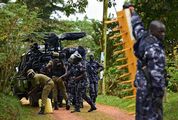WITH temperatures reaching record highs last week and warnings that the drought could result in SA’s maize crop plummeting to less than half the country’s annual consumption, the text that opens the rural chapter of the National Development Plan (NDP) seems particularly apt: "Our land is our home …. From time to time it reminds us of its enormous infinite power when rain and floods overwhelm, winds buffet, seas rage and the sun beats unrelentingly in drought. In humility we learn of our limitations."
If nothing else, the severe drought should serve as a reminder of just how important agriculture is for SA and its economy, and how seriously we should take it — commercial farming, that is, not only land reform or the creation of smallholder farmers.
Even the NDP’s chapter tends to focus more on the need to tackle rural poverty and to build a more inclusive agricultural sector than it does on how to support existing farmers who produce much of the food SA consumes. The NDP proposes expanding agricultural land under irrigation, but it tends to assume that commercial farmers — large and small — are doing just fine. There is very little attention paid to the production of maize, SA’s staple food.
Rough estimates from AgriSA are that the sector could require up to R20bn in emergency assistance to survive the drought, the most severe SA has seen since the early 1990s. The height of the maize planting season is past and it was too dry for many farmers to plant, so as much as 70% of farmland marked for white maize is lying fallow.
Official crop estimates are due out at the end of this month, but GrainSA believes the crop could be as small as 5-million tonnes — down from an already poor 9.9-million tonnes last year and well below the 10.5-million SA needs to provide maize meal for people and feed for livestock. SA has also traditionally supplied its neighbours with maize.
The only question now is how much maize SA will have to import. Expectations of a shortage, particularly of white maize, have already seen white maize prices soar by 60% to a historic high of R4,900 a tonne — well above the import parity price. That will fuel inflation, not only in grain prices, but also in the prices of chicken, eggs and meat.
The Reserve Bank’s monetary policy committee will have to look at the food price outlook in its interest rate decision when it meets later this month, along with the other big factor fuelling inflation: the ever-sliding rand.
Agriculture’s woes are also likely to further dent economic growth. The maize shortage, and other drought-affected crops, will also affect the balance of payments because instead of exporting as it frequently does, SA will be importing — and expensively given the weak rand.
That’s a severe reversal. SA has been a net exporter of maize for the past 50 years, except in the devastating drought years of 1984, 1992 and 2007. SA has traditionally been a net agricultural exporter more broadly and that is likely to be under threat this year.
All of which should serve to focus minds on the health or otherwise of SA’s commercial agriculture sector, as well as on the plight of its small farmers and agricultural workers, whose livelihoods could be devastated by the drought. The Department of Agriculture, Forestry and Fisheries published an agricultural policy action plan in late 2014. But lately, the government has done more to undermine confidence in the sector than to build it, creating huge uncertainty among farmers and deterring investment with talk about forced transfers of stakes in farms, for example.
The government needs to assess, as a matter of urgency, what needs to be done to mitigate the worst effects of the drought on the economy in the short term. And the drought should act as a sign to take the sector more seriously.
PARCHED: A cattle farm in Jozini, in northern KwaZulu-Natal. Picture: KHAYA NGWENYA
WITH temperatures reaching record highs last week and warnings that the drought could result in SA’s maize crop plummeting to less than half the country’s annual consumption, the text that opens the rural chapter of the National Development Plan (NDP) seems particularly apt: "Our land is our home …. From time to time it reminds us of its enormous infinite power when rain and floods overwhelm, winds buffet, seas rage and the sun beats unrelentingly in drought. In humility we learn of our limitations."
If nothing else, the severe drought should serve as a reminder of just how important agriculture is for SA and its economy, and how seriously we should take it — commercial farming, that is, not only land reform or the creation of smallholder farmers.
Even the NDP’s chapter tends to focus more on the need to tackle rural poverty and to build a more inclusive agricultural sector than it does on how to support existing farmers who produce much of the food SA consumes. The NDP proposes expanding agricultural land under irrigation, but it tends to assume that commercial farmers — large and small — are doing just fine. There is very little attention paid to the production of maize, SA’s staple food.
Rough estimates from AgriSA are that the sector could require up to R20bn in emergency assistance to survive the drought, the most severe SA has seen since the early 1990s. The height of the maize planting season is past and it was too dry for many farmers to plant, so as much as 70% of farmland marked for white maize is lying fallow.
Official crop estimates are due out at the end of this month, but GrainSA believes the crop could be as small as 5-million tonnes — down from an already poor 9.9-million tonnes last year and well below the 10.5-million SA needs to provide maize meal for people and feed for livestock. SA has also traditionally supplied its neighbours with maize.
The only question now is how much maize SA will have to import. Expectations of a shortage, particularly of white maize, have already seen white maize prices soar by 60% to a historic high of R4,900 a tonne — well above the import parity price. That will fuel inflation, not only in grain prices, but also in the prices of chicken, eggs and meat.
The Reserve Bank’s monetary policy committee will have to look at the food price outlook in its interest rate decision when it meets later this month, along with the other big factor fuelling inflation: the ever-sliding rand.
Agriculture’s woes are also likely to further dent economic growth. The maize shortage, and other drought-affected crops, will also affect the balance of payments because instead of exporting as it frequently does, SA will be importing — and expensively given the weak rand.
That’s a severe reversal. SA has been a net exporter of maize for the past 50 years, except in the devastating drought years of 1984, 1992 and 2007. SA has traditionally been a net agricultural exporter more broadly and that is likely to be under threat this year.
All of which should serve to focus minds on the health or otherwise of SA’s commercial agriculture sector, as well as on the plight of its small farmers and agricultural workers, whose livelihoods could be devastated by the drought. The Department of Agriculture, Forestry and Fisheries published an agricultural policy action plan in late 2014. But lately, the government has done more to undermine confidence in the sector than to build it, creating huge uncertainty among farmers and deterring investment with talk about forced transfers of stakes in farms, for example.
The government needs to assess, as a matter of urgency, what needs to be done to mitigate the worst effects of the drought on the economy in the short term. And the drought should act as a sign to take the sector more seriously.























Change: 0.19%
Change: 0.37%
Change: 0.27%
Change: -0.19%
Change: 1.75%
Data supplied by Profile Data
Change: 1.50%
Change: -0.13%
Change: 0.19%
Change: 0.00%
Change: 0.00%
Data supplied by Profile Data
Change: -0.89%
Change: -3.03%
Change: -2.11%
Change: -1.47%
Change: -0.22%
Data supplied by Profile Data
Change: -1.39%
Change: -1.49%
Change: -1.63%
Change: 0.00%
Change: 4.70%
Data supplied by Profile Data